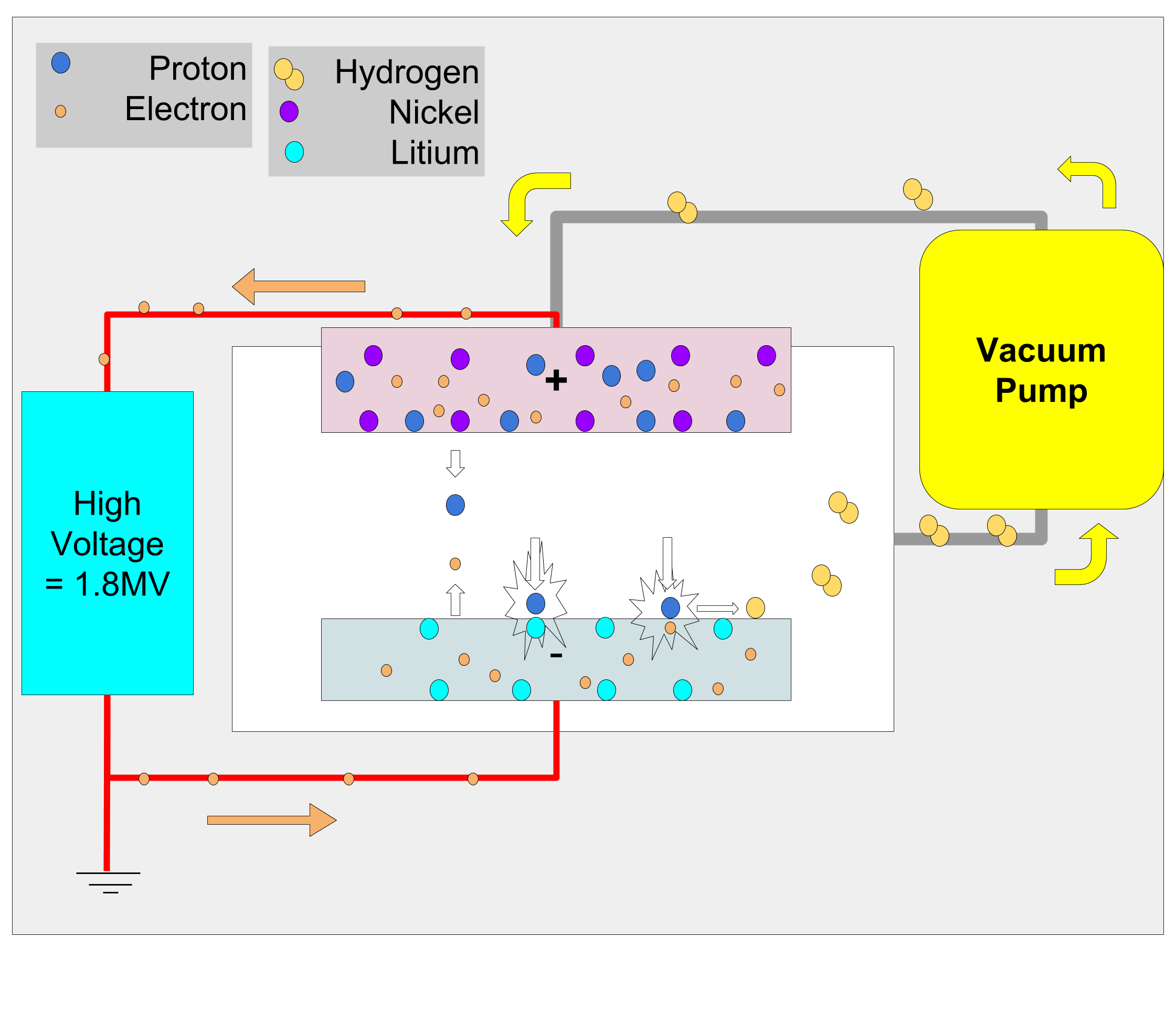 The neutron generator中性子発生装置
The neutron generator中性子発生装置
Overview概要

We propose a new fusion reactor which is not a conventional plasma compression system, but, small, lightweight, inexpensive. 従来のプラズマ圧縮方式ではない、小型、軽量、安価な新しい核融合炉
Prepare a positive electrode and a negative electrode inside a vacuum container. 真空容器内部に正極と負極を用意する。
The positive electrode is made of nickel and has a hydrogen occlusion performance. Also, the positive electrode protrudes from the vacuum container. However, the positive electrode is electrically insulated from the vacuum container. Platinum is thinly coated on the protruding surface. The platinum film is pressurized with hydrogen gas. Platinum acts as a catalyst, separates hydrogen gas into hydrogen atoms, hydrogen atoms separate into protons and electrons and they penetrate into nickel. The number of hydrogen atoms, that is, the number of moles of protons is about 10% with respect to the number of moles of nickel. 正極はニッケルでできており水素吸蔵性能を持たせる。また、正極は真空容器からはみ出している。ただし、正極は真空容器と電気的に絶縁されている。はみ出し表面にはプラチナが薄くコーティングされている。このプラチナ膜に、水素ガスが加圧されている。プラチナは触媒として働き水素ガスを水素原子に分離し水素原子は陽子と電子に分離してニッケル内部に浸透していく。ニッケルのモル数に対して水素原子つまり陽子のモル数は10%程度とする。
Before operation, the vacuum vessel is sufficiently swept by a vacuum pump. During operation, the gas that can be generated inside is hydrogen gas. As the internal hydrogen gas becomes an obstacle to nuclear fusion, the vacuum pump continues to sweep. The swept hydrogen gas is again pressurized to the positive electrode. 運転前に真空容器は真空ポンプで充分に掃引される。運転中に、内部に発生しうるガスは水素ガスである。内部の水素ガスは、核融合の障害となるため、真空ポンプの掃引は続ける。掃引した水素ガスは、再び正極に加圧される。
The negative electrode is made of lithium, it is insulated from the vacuum container and in the vacuum container. Since lithium has a low melting point, it is placed on a nonconductor ceramic jar that resists high heat. 負極はリチウムでできており真空容器と絶縁されて真空容器内部にある。リチウムは融点が低いため、高熱に耐える不導体のセラミックの壺に乗せられている。
A high voltage of 1.8 million volts is applied to the positive electrode and the negative electrode. High voltage can be easily generated by Cockcroft · Walton circuit. The high voltage may be a pulse of weak current. Earth is taken so that electrons are hardly emitted from the lithium of the negative electrode. From the positive electrode, protons are radiated, pushing through the vacuum, acquiring kinetic energy of 1.8 MeV, and colliding with lithium. A nuclear reaction of protons and lithium occurs. Hydrogen that failed to react dissolves in lithium. That is, not only lithium but also protons accumulate in the negative electrode. When this proton reacts with the hydrogen coming from the positive electrode, it becomes deuterium. In any case, a complicated nuclear reaction occurs at the negative electrode. 正極と負極には、180万ボルトの高電圧をかける。高電圧はコッククロフト・ウォルトン回路で容易に発生できる。高電圧は微弱電流のパルスでよい。負極のリチウムから電子が放射され難いようにアースをとる。正極からは、陽子が放射され、真空中を突き進み、1.8 MeVの運動エネルギーを獲得し、リチウムと衝突する。陽子とリチウムの核反応が起きる。反応を起こせなかった水素はリチウムに溶け込む。つまり負極はリチウムだけでなく、陽子がたまっていく。この陽子が正極から来た水素と反応すれば重水素になる。いずれにしろ、負極では複雑な核反応が発生する。
Some electrons may be radiated from the negative electrode and react with the positive electrode in a nuclear reaction. 一部の電子が負極から放射され正極と核反応をする可能性がある。
Inside the container, some protons and electrons recombine to form hydrogen atoms. Hydrogen atoms form hydrogen molecules. This hydrogen gas is swept by a vacuum pump. また容器内では、一部の陽子と電子が再結合して水素原子となる。水素原子は水素分子を形成する。この水素ガスは真空ポンプで掃引される。
According to the nuclear reaction simulation program (with source code), the nuclear energy (COP) generated for the input high voltage power is 11 to 12 times. Using the generated nuclear energy as a heat source, electricity can be generated with efficiency of 30%. Independent continuous operation is possible if 1/3 of the generated power is re-applied to a high voltage of 1.8 million volts. The remaining two thirds of electricity can be supplied outside the equipment. Also, the remaining 70% of waste heat can be used for heating, steam engine, etc. That is, the present apparatus can be a compact, lightweight, inexpensive fusion reactor. 核反応のシミュレーションプログラム(ソースコード公開)によれば、投入された高電圧の電力に対して発生する核エネルギー(COP)は、11倍から12倍である。発生する核エネルギーを熱源として30%の効率で発電ができる。発生した電力の1/3を180万ボルトの高電圧に再投入すれば、独立した連続運転ができる。余った2/3の電力は装置の外に供給できる。また、残りの70%の廃熱は、暖房や蒸気機関等に利用することができる。つまり、本装置は小型、軽量、安価な核融合炉になりうる。
Whether this device succeeds or not depends on whether the positive electrode can stably emit protons. この装置が成功するかどうかは、正極が安定的に陽子を放射できるかどうかにかかっている。
Looking for partnersパートナー募集
We are preferentially looking for a partner who can experiment a prototype of the neutron generator. In addition, we are looking for partners who can investigate, research, development, production, sale the neutron generator and cooperate with public relations. If you would like to become a partner, please contact after you have accepted the following partner agreement. 中性子発生装置を試作し実験をしていただける方を探しています。合わせて、中性子発生装置についてのその他活動に協力していただける方も探しています。パートナーを希望される方は、以下のパートナー契約内容を承諾されてから連絡をお願いします。
Papers論文
- Simulation of the neutron generator. (Feb. 16, 2017, The third version.)
- Electron Capture Properties (Nov. 14, 2016)
- The probability of an electron captured by a proton (Nov. 7, 2016)
-
Simulation of the neutron generator (The second version) (Sep. 25, 2016)(OBSOLETED廃止) -
Simulation of the neutron generator without hydrogen. (Jul. 29, 2016)(OBSOLETED廃止) -
One Month Simulation of the neutron generator. (Jul. 25, 2016)(OBSOLETED廃止) -
Simulation of the neutron generator. (Jun. 29, 2016)(OBSOLETED廃止) - The Passed Energy of Compton scattering. (Jan. 4, 2016)
-
Generate neutrons, deuteriums and energy. (Dec. 16, 2015)(OBSOLETED廃止)
Programs and Dataプログラムとデータ
- GitHub repository of the Simulator of the neutron generator 中性子発生装置のシミュレーターの GitHub リポジトリ (shinx55/neutron_generator)
- All log data of the Simulation of the neutron generator. (235[MB]tar.gz) (Feb. 17, 2017) 中性子発生装置のシミュレーションの全ログデータ (235[MB]tar.gz) (2017/02/17)
Contact us問い合わせ
Patent特許
BLOGブログ
ICCF20
I participated in the ICCF20 ( 20th International Conference on Condensed Matter Nuclear Science ) during October 2-7, 2016. ICCF20 ( 20th International Conference on Condensed Matter Nuclear Science, 2016年10月2-7日) に参加しました。
 KOSHIRYOKU Laboratory Ltd.株式会社好試力研究所
KOSHIRYOKU Laboratory Ltd.株式会社好試力研究所